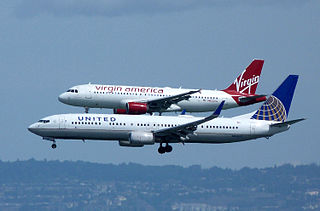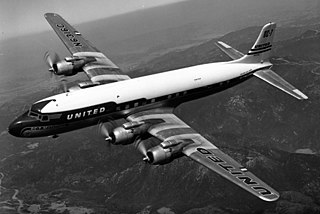
An airliner is a type of aircraft for transporting passengers and air cargo. Such aircraft are most often operated by airlines. Although the definition of an airliner can vary from country to country, an airliner is typically defined as an airplane intended for carrying multiple passengers or cargo in commercial service. The largest of them are wide-body jets which are also called twin-aisle because they generally have two separate aisles running from the front to the back of the passenger cabin. These are usually used for long-haul flights between airline hubs and major cities. A smaller, more common class of airliners is the narrow-body or single-aisle. These are generally used for short to medium-distance flights with fewer passengers than their wide-body counterparts.

Western Airlines was a major airline based in California, operating in the western United States including Alaska and Hawaii, and western Canada, as well as to New York City, Boston, Washington, D.C., and Miami and to Mexico, London and Nassau. Western had hubs at Los Angeles International Airport, Salt Lake City International Airport, and the former Stapleton International Airport in Denver. Before it merged with Delta Air Lines in 1987 it was headquartered at Los Angeles International Airport (LAX). Throughout the company's history, their slogan was "Western Airlines...The Only Way to Fly!"

The Boeing 377 Stratocruiser was a large long-range airliner developed from the C-97 Stratofreighter military transport, itself a derivative of the B-29 Superfortress. The Stratocruiser's first flight was on July 8, 1947. Its design was advanced for its day; its innovative features included two passenger decks and a pressurized cabin. It could carry up to 100 passengers on the main deck plus 14 in the lower deck lounge; typical seating was for 63 or 84 passengers or 28 berthed and five seated passengers.

The Douglas C-54 Skymaster is a four-engined transport aircraft used by the United States Army Air Forces in World War II and the Korean War. Like the Douglas C-47 Skytrain derived from the DC-3, the C-54 Skymaster was derived from a civilian airliner, the Douglas DC-4. Besides transport of cargo, the C-54 also carried presidents, prime ministers, and military staff. Dozens of variants of the C-54 were employed in a wide variety of non-combat roles such as air-sea rescue, scientific and military research, and missile tracking and recovery. During the Berlin Airlift it hauled coal and food supplies to West Berlin. After the Korean War it continued to be used for military and civilian uses by more than 30 countries. It was one of the first aircraft to carry the President of the United States, the first being President Franklin D. Roosevelt during World War II.

The Douglas DC-6 is a piston-powered airliner and cargo aircraft built by the Douglas Aircraft Company from 1946 to 1958. Originally intended as a military transport near the end of World War II, it was reworked after the war to compete with the Lockheed Constellation in the long-range commercial transport market. More than 700 were built and many still fly today in cargo, military, and wildfire control roles.

The Douglas DC-7 is an American transport aircraft built by the Douglas Aircraft Company from 1953 to 1958. A derivative of the DC-6, it was the last major piston engine-powered transport made by Douglas, being developed shortly after the earliest jet airliner—the de Havilland Comet—entered service and only a few years before the jet-powered Douglas DC-8 first flew. Unlike other aircraft in Douglas's line of propeller-driven aircraft, no examples remain in service in the present day, as compared to the far more successful DC-3 and DC-6.
British South American Airways (BSAA) was a state-run airline in the United Kingdom in the late 1940s responsible for services to the Caribbean and South America. Originally named British Latin American Air Lines it was renamed before services started in 1946. BSAA operated mostly Avro aircraft: Yorks, Lancastrians and Tudors and flew to Bermuda, the West Indies, Mexico and the western coast of South America. After two high-profile aircraft disappearances it was merged into the British Overseas Airways Corporation at the end of 1949.

Schreiner Airways was a charter, passenger and cargo airline based in the Netherlands.

Combi aircraft in commercial aviation are aircraft that can be used to carry either passengers as an airliner, or cargo as a freighter, and may have a partition in the aircraft cabin to allow both uses at the same time in a mixed passenger/freight combination. The name combi comes from the word combination, and is derived from the famous Volkswagen Type 2 van, often called the "Kombi" van, specifically the Kombinationskraftwagen variant, with side windows and removable rear seats, which both a passenger and a cargo vehicle combined.

Juneau International Airport is a city-owned, public-use airport and seaplane base located seven nautical miles northwest of the central business district of Juneau, a city and borough in the U.S. state of Alaska that has no direct road access to the outside world. The airport serves as a regional hub for all air travel, from bush carriers to major U.S. air carriers such as Alaska Airlines.

The Avro Type 688 Tudor was a British piston-engined airliner based on Avro's four-engine Lincoln bomber, itself a descendant of the famous Lancaster heavy bomber, and was Britain's first pressurised airliner. Customers saw the aircraft as little more than a pressurised DC-4, and few orders were forthcoming, important customers preferring to buy US aircraft. The tailwheel undercarriage layout was also dated and a disadvantage.

Trans-Canada Air Lines Flight 304 was operated by a Vickers Viscount 700 aircraft owned by Trans-Canada Air Lines. On July 9, 1956, the No. 4 propeller of the aircraft tore loose from its engine over Flat Rock, Michigan in the United States, during a flight from Chicago, Illinois, to Toronto, Ontario, and Montreal, Quebec; one blade of the propeller sliced through the passenger section of the cabin, killing one passenger and injuring four passengers and one flight attendant. The aircraft diverted to Windsor, Ontario, in Canada, and the pilots carried out an emergency landing. The accident was the first to involve a Vickers Viscount aircraft in scheduled service, and was the first instance of a propeller loss on a turbo-prop aircraft.

The Martin 2-0-2 was an airliner introduced in 1947. The twin piston-engined fixed-wing aircraft was designed and built by the Glenn L. Martin Company.

The Canadair North Star is a 1940s Canadian development, for Trans-Canada Air Lines (TCA), of the Douglas DC-4. Instead of radial piston engines used by the Douglas design, Canadair used Rolls-Royce Merlin V12 engines to achieve a higher cruising speed of 325 mph (523 km/h) compared with the 227 mph (365 km/h) of the standard DC-4. Requested by TCA in 1944, the prototype flew on 15 July 1946. The type was used by various airlines and by the Royal Canadian Air Force (RCAF). It proved to be reliable but noisy when in service through the 1950s and into the 1960s. Some examples continued to fly into the 1970s, converted to cargo aircraft.

Varig Flight 967 was an international cargo flight that disappeared on 30 January 1979 while en route from Narita International Airport in Japan to Rio de Janeiro–Galeão International Airport in Brazil, with a stopover in Los Angeles International Airport. Neither the aircraft, a Boeing 707-323C cargo aircraft, nor the six crew members have ever been found.

On 2 February 1953, an Avro York four-engined piston airliner registered G-AHFA of Skyways Limited disappeared over the North Atlantic on a flight from the United Kingdom to Jamaica. The aircraft had 39 occupants including 13 children.

Northwest Orient Airlines Flight 307 was a scheduled international flight with several domestic legs in the United States with the routing Washington, DC–Detroit–Madison–Rochester–Minneapolis-St. Paul–Winnipeg. On 7 March 1950, the flight was operated by a Martin 2-0-2, registered N93050, when it crashed into a house on approach to Minneapolis-Saint Paul International Airport after first hitting a flagpole. The three crew members and ten passengers on board were all killed, as were two children in the house.
















